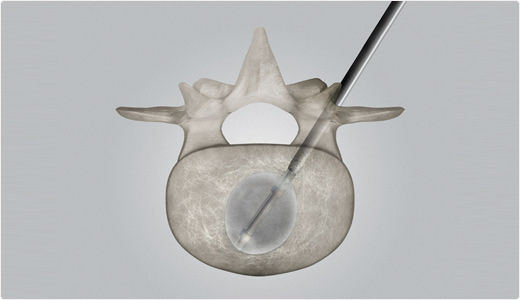Balloon catheter real-time simulation (BaCaRTS)
Thesis by: tbaAdvisor: Prof. Dr. Nassir Navab
Supervision by: Patrick Wucherer, Philipp Stefan
Overview

http://www.medicalexpo.com/prod/carefusion/product-75330-501940.html
Topic
Development of realistic computational model for instrument-tissue interaction.Background
An essential component of the kyphoplasty procedure is the inflation of the balloon catheter. Before the cement injection to stabilize the fractured vertebra, a cavity is created in the vertebra in order to (i) compact spongy bone towards the vertebral wall and (ii) to restore the vertebral height and correct the kyphotic deformity. Currently, the balloon catheter is modeled, like the bone cement, by a simple polygonalDevelopment
An approach towards simulation of fluid flow inside a porous medium has been proposed by Lenaerts et al. [Lenaerts2008]. Their approach uses a mesh-free smoothed particle hydrodynamics (SPH) method and treats porous flow at a macroscopic scale, modeling cavities and pores of a region in the volume implicitly as a parameter of a porous particle. This has the advantage that the porous material can be deformed and absorption or emission at the boundary of the deformable body can be easily handled. Simulation of bone cement diffusion in osteoporotic bone using a SPH model based on CT imaging data has been done by [Basafa2010]. However, both methods do not simulate the diffusion process in real-time. Moreover, variable viscosity and temperature, i.e. in case of the bone cement due to the exothermic polymerization process, have not been considered. Yet SPH-based simulation of particle diffusion processes with varying viscosity and temperature at interactive frame rates using GPU-accelerated algorithms is feasible even with high particle counts [Hérault2011]. Besides the application to simulation of fluid flow, SPH has been applied to modeling solid mechanics problems. [Das2008] prefer it over mesh-based methods for fracture prediction problems, because it avoids the inaccuracy and instability issues involved in ensuring integrity and quality of a mesh during extreme deformations and discontinuities, e.g. fracture and fragmentation. They combine a SPH formulation for elastic solid deformation with a continuum damage model to simulate brittle fracture. SPH has been shown by [Fernandez2010] to be a suitable method to model bone structures from radiography data including bone remodeling without the need of re-meshing. Using a GPU-accelerated mesh-free SPH approach based on the CT imaging data we achieve a computational model for realistic real-time simulation of the brittle, porous material of the bone and the interaction of bone cement and instruments with it.Contribution
The research goal contributes to the complete simulation of a minimally invasive surgery (MIS) called “kyphoplasty”.What do we offer
- Experience different fields of research in computer science: Visualization, Software Engineering, Real-time Simulation, GPU Programming
- Potentially the co-authorship on research papers submitted to prestigious conferences/journals (depending on student performance)
- We offer an intensive supervision, but initiative is very welcome. Working environment will be provided at the NARVIS lab or the simulation center Institut für Notfall-und Medizinmanagement (INM).
Requirements
- Interest in interdisciplinary research field
- Basic knowledge of Python are required
- C++ knowledge would be preferable
Contact
Literature
- [Lenaerts2008] T. Lenaerts, B. Adams, and P. Dutré, ‘Porous Flow in Particle-based Fluid Simulations’, in ACM SIGGRAPH 2008 Papers, New York, NY, USA, 2008, pp. 49:1–49:8.
- [Basafa2010] E. Basafa, Y. Otake, M. D. Kutzer, R. S. Armiger, and M. Armand, ‘A Particle-Based Model for Prediction of Cement Diffusion during Osteoporotic Hip Augmentation Surgery: Theory and Validation’, Proceedings ASME International Mechanical Engineering Conference & Exposition, p. 12–18, 2010.
- [Hérault2011] A. Hérault, G. Bilotta, A. Vicari, E. Rustico, and C. D. Negro, ‘Numerical simulation of lava flow using a GPU SPH model’, Ann. Geophys., vol. 54, no. 5, Dec. 2011.
- [Das2008] R. Das and P. W. Cleary, ‘Studying the Effect of Rock Shape on Brittle Fracture Pattern Using a Mesh-free Method SPH’, in Proceedings of the World Congress on Engineering, London, 2008.
- [Fernandez2010] J. W. Fernandez, R. Das, C. D. L. Thomas, P. W. Cleary, M. D. Sinnott, and J. Clement, ‘Strain Reduction between Cortical Pore Structures Leads to Bone Weakening and Fracture Susceptibility: An Investigation Using Smooth Particle Hydrodynamics’, in 6th World Congress of Biomechanics (WCB 2010). vol. 31, pp. 784–787, 2010.
| ProjectForm | |
|---|---|
| Title: | Balloon catheter real-time simulation (BaCaRTS) |
| Abstract: | http://campar.in.tum.de/view/Students/ProjectForm |
| Student: | |
| Director: | Prof. Dr. Nassir Navab |
| Supervisor: | Patrick Wucherer, Philipp Stefan |
| Type: | DA/MA/BA |
| Area: | |
| Status: | finished |
| Start: | |
| Finish: | |
| Thesis (optional): | |
| Picture: | |
| I | Attachment  | Action | Size | Date | Who | Comment |
|---|---|---|---|---|---|---|
| | spine-augmentation-system-balloon-catheter-percutaneous-kyphoplasty-75330-2997655.jpg | manage | 15.5 K | 07 Oct 2015 - 20:19 | PatrickWucherer |